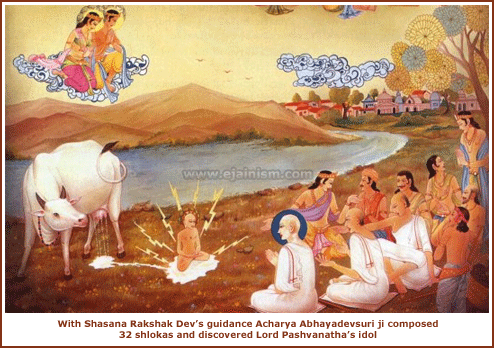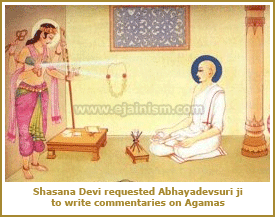A Story of Abhayadevsuri
Abhayadevsuri ji has earned immense fame by composing Sanskrit commentaries on 9 of the Jain agamas (Jain canonical literature). These commentaries provide a key to the innermost deep meaning of Jain agama literature. Besides being brief and well-worded, these commentaries depict and discuss many topics. Thus his name ranks at the top of those Acharyas who have written books with a view to immortalizing the pure tradition of Jinagama.
Acharya Abhayadevsuri was born in a Vaishya (merchant) family in 1015 A.D. He was born to Mahidhara Sheth and Dhandevi in the famous city of Dhara of Malavdesha. Once, Shri Jineshwarsuri and Shri Buddhisagarsuri came to Dhara. Having listened to their religious discourses, he felt an inclination for renunciation. With the permission of his parents he accepted initiation from Jineshwarsuri. He began his studies of Agama literature at a very young age and in course of time he was honored with the title of Acharya (head of a mendicant group).
It is said that one night when Acharya Abhayadevsuri was engrossed in meditation, Shasana Devi (the guardian Goddess) revealed herself before him and said that the commentaries of two agamas namely, Acharanga and Sutrakrutanga, were well-preserved but other commentaries were lost and destroyed with the passage of time. The goddess then asked him to make efforts to remedy that deficiency so as to serve the interests of Shrisangha (congregation).
Acharya Abhayadevsuri accepted this enormous task. He commenced the writing of commentary by performing ayambila tapa, type of religions austerity. After prolonged and laborious efforts he wrote volumes of commentaries on anga-agama (canonical text, one of the twelve). Because of constant penance of Ayambila and working for many nights together, he developed a leucoderma like disease. Consequently his opponents spread the rumor that the mother-goddess had cursed him with this disease as a penalty for having wrongly interpreted the scriptures.

Acharya Abhayadevsuri invoked Shasana Rakshak Dev (the guardian God) Dharanendra at night and as the god appeared before him, Acharya said, “O Lord! I am least afraid of my death but I can’t endure the false charges and criticism that the slandering people level against me since I am afflicted with the disease. Hence I have decided to undertake fast till I die.”
Shasana Rakshak Dev Dharanendra assured him that he was quite innocent and provided him necessary guidance. As guided by Dharanendra, Abhayadevsuri, together with the shravaka sangha, came at the banks of river Sedhi in Stambhangrama. Acharyashri discovered the place where a cow was yielding milk automatically. Soon he composed a stotra of 32 shlokas entitled Jayatiahuan. As the stotra was composed, a very ancient and bejeweled idol of Shri Stambhan Parshvanath emerged from under the ground. Shri sangha performed all the rituals of bathing and as soon as the holy water was applied to the body of Abhayadevsuri ji, he was cured of the disease. Acharyashri regained his usual health. Presently the same idol is installed at the temple in Cambay.
Then Acharyashri completed the task of writing Navangi commentary, and he expired at Kapadvanja in Gujarat and the samadhi, the memorial structure, exists there in Tapagaccha upashraya.
